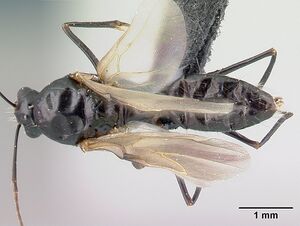Camponotus liandia
| Camponotus liandia | |
|---|---|

| |
| Scientific classification | |
| Kingdom: | Animalia |
| Phylum: | Arthropoda |
| Class: | Insecta |
| Order: | Hymenoptera |
| Family: | Formicidae |
| Subfamily: | Formicinae |
| Tribe: | Camponotini |
| Genus: | Camponotus |
| Subgenus: | Myrmosaga |
| Species: | C. liandia |
| Binomial name | |
| Camponotus liandia Rakotonirina & Fisher, 2018 | |
This species is generally known from coastal scrub and littoral forest in the east, montane rainforest, grassland, shrubland, savannah grassland, woodland, and Uapaca woodland on the central high plateau of Madagascar. It has also colonized dry forest on tsingy and burned savannah in the west, degraded forest below granite outcroppings, and montane shrubland on rock in the high plateau. Nests are established in rotten logs, under stones, and in the ground. Workers may forage on the ground and on low vegetation. (Rakotonirina & Fisher, 2022)
Identification
In full-face view, lateral margins of head anterior to eye level diverging posteriorly; anterior clypeal margin broadly triangular.
Camponotus liandia presents two morphological variations: a matte integument covered with microreticulate sculpture, and a smooth and shining body. The first form has been observed from samples collected from the Forêt d’Atsirakambiaty in the grassland of the south-central high plateau. The second form occupies coastal scrub and littoral forest in the east and dry forest on Tsingy and burned savannah in the west.
Camponotus liandia was originally described under the subgenus Mayria (Rakotonirina and Fisher 2018) but the presence of a median carina on a broadly projected rectangular clypeus and a dorsally tapering petiolar node that are a few of the strong features characterizing the subgenus Myrmosaga has led to the placement of the species to this latter subgenus. The subgenus Mayria has generally rounded anterior clypeal margin and a nodiform petiole. (Rakotonirina & Fisher, 2022)
Keys including this Species
- Key to Malagasy Camponotus Mayria
- Key to minor workers of the Malagasy Camponotus, subgenus Myrmosaga
Distribution
Latitudinal Distribution Pattern
Latitudinal Range: -20.06784° to -23.45373°.
| North Temperate |
North Subtropical |
Tropical | South Subtropical |
South Temperate |
- Source: AntMaps
Distribution based on Regional Taxon Lists
Malagasy Region: Madagascar (type locality).
Distribution based on AntMaps
Distribution based on AntWeb specimens
Check data from AntWeb
Countries Occupied
| Number of countries occupied by this species based on AntWiki Regional Taxon Lists. In general, fewer countries occupied indicates a narrower range, while more countries indicates a more widespread species. |

|
Estimated Abundance
| Relative abundance based on number of AntMaps records per species (this species within the purple bar). Fewer records (to the left) indicates a less abundant/encountered species while more records (to the right) indicates more abundant/encountered species. |

|
Biology
Castes
Worker
Images from AntWeb
   
| |
| Worker (major/soldier). Specimen code casent0053952. Photographer Erin Prado, uploaded by California Academy of Sciences. | Owned by CAS, San Francisco, CA, USA. |
Queen
Images from AntWeb
    
| |
| Queen (alate/dealate). Specimen code casent0053950. Photographer Erin Prado, uploaded by California Academy of Sciences. | Owned by CAS, San Francisco, CA, USA. |
Male
Images from AntWeb
     
| |
| Male (alate). Specimen code casent0179439. Photographer Erin Prado, uploaded by California Academy of Sciences. | Owned by CAS, San Francisco, CA, USA. |
Nomenclature
The following information is derived from Barry Bolton's Online Catalogue of the Ants of the World.
- liandia. Camponotus liandia Rakotonirina & Fisher, 2018: 33, figs. 6A, 19, 25 (s.w.) MADAGASCAR.
- Combination in C. (Mayria): Rakotonirina & Fisher, 2018: 33.
Unless otherwise noted the text for the remainder of this section is reported from the publication that includes the original description.
Description
Worker
Minor. In full-face view, head elongate and rectangular, lateral margins parallel, posteriorly rounding to a more or less straight posterior margin. Anterior clypeal margin projecting into obtusely angulate lobe. Eyes not breaking lateral outlines of head, their posterior margins located far behind the mid-length of the head (PoOc/CL: 0.26±0.01; 0.24–0.27). Mandible triangular, masticatory margin with six teeth. Antennal scape long, roughly its distal half surpassing posterior cephalic margin. In lateral view, pronotum and mesonotum convex; propodeal dorsum slightly concave medially; junction of propodeal dorsum and declivity surface broadly rounded; propodeal dorsum approximately three times longer than height of declivity; propodeal spiracle slit-like. Petiolar node tapering dorsally.
Dorsum of head, mesosoma, petiole, and gaster covered with scattered erect hairs, shorter than height of propodeal declivity, and abundant, long pubescence. Body color reddish-black to black.
Major. Differing from minor worker in the following characters: larger head, with slight medial concavity on posterior margin; more or less straight anterior clypeal margin; antennal scape barely surpassing posterior cephalic margin; in lateral view, mesosoma characterized by even convexity of pronotum and mesonotum, separated from propodeum by distinct metanotum.
Type Material
Holotype worker. Madagascar: Province Antananarivo, Andohony I Non Protected Area, 22.62 km SW Antsirabe, -20.06784, 46.99068, 1451 m, transect subsample #16, soil digging 20 sample transect, 10 m, ex soil, Savannah grassland, 6–7 Mar 2012 (A. Ravelomanana) collection code: ARA1637, specimen code: CASENT0803903 (California Academy of Sciences).
Paratypes. 4 workers with same data as holotype but with specimen codes: CASENT0803901, CASENT0803902, CASENT0803904, CASENT0803905; 4 workers with collection code: ARA1636, specimen codes: CASENT0803900, CASENT0803897, CASENT0803898, CASENT0803899 (CASC, The Natural History Museum, Musee d'Histoire Naturelle Genève, Parc Botanique et Zoologique de Tsimbazaza).
References
- Rakotonirina, J.C., Fisher, B.L. 2018. Taxonomic revision of the Malagasy Camponotus subgenus Mayria (Hymenoptera, Formicidae) using qualitative and quantitative morphology. Zootaxa 4438: 1–58 (DOI 10.11646/zootaxa.4438.1.1).
- Rakotonirina, J.C., Fisher, B.L. 2022. Revision of the Malagasy Camponotus subgenus Myrmosaga (Hymenoptera, Formicidae) using qualitative and quantitative morphology. ZooKeys 1098: 1–180 (doi:10.3897/zookeys.1098.73223).

